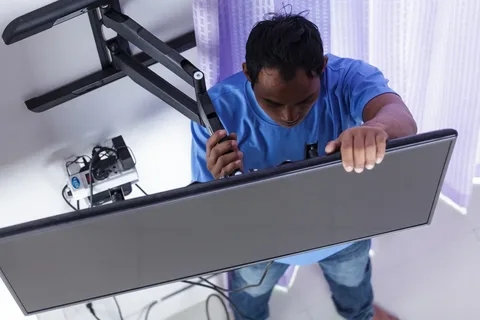Flat panel installations have revolutionized modern interior design, providing sleek aesthetics, space efficiency, and a contemporary feel. Whether in residential or commercial spaces, the integration of flat panels enhances the visual appeal and functionality of any environment. From television screens to cabinetry and wall panels, achieving a seamless installation requires precision, expertise, and an understanding of various techniques and materials.
Understanding Flat Panel Installation
Flat panel installation refers to the process of mounting or integrating flat panels into walls, furniture, or other surfaces. These panels could be televisions, decorative wall panels, or custom-built cabinetry with flush, minimalist designs. The goal is to create a clean and uninterrupted surface that enhances the space’s overall appeal.
In modern homes and offices, flat panel installation are commonly used for:
- Wall-mounted televisions and display screens
- Sleek, handle-free kitchen and bathroom cabinetry
- Acoustic wall panels for sound absorption
- Custom wall features for aesthetic enhancement
Each installation type demands careful planning and precise execution to ensure durability, functionality, and seamless aesthetics.
Benefits of Flat Panel Installation
- Sleek and Modern Appearance
Flat panels contribute to a streamlined and minimalist look that complements contemporary interiors. The absence of bulky elements creates a clean and uncluttered appearance.
- Space Optimization
Mounted flat panels free up floor space, making rooms appear more spacious and organized. In smaller apartments or offices, this installation technique maximizes efficiency.
- Enhanced Safety and Durability
Properly installed flat panels reduce the risk of accidents caused by loose or unstable setups. A secure installation prevents tipping or damage over time.
- Improved Functionality
Many flat panel installations, such as cabinetry or acoustic panels, enhance usability by incorporating smart storage solutions or noise reduction properties.
- Aesthetic Versatility
Flat panels come in various finishes, materials, and styles, allowing homeowners and designers to customize installations according to their design preferences.
Steps for a Successful Flat Panel Installation
1. Planning and Preparation
Before installation, it is essential to assess the location, panel type, and mounting method. Consider the following factors:
- Wall Structure: Ensure the surface can support the panel’s weight.
- Power and Wiring: Plan for hidden cables and power sources for a clean finish.
- Panel Material: Different materials require specific mounting techniques.
- Desired Aesthetic: Determine whether the installation will be flush with the wall or slightly protruding.
2. Choosing the Right Mounting System
The choice of mounting hardware depends on the type of panel being installed. Common options include:
- Fixed Mounts: Ideal for flat screens and decorative panels that do not require movement.
- Tilting Mounts: Allow for slight adjustments, especially useful for televisions.
- Full-Motion Mounts: Provide flexibility for repositioning screens or panels.
- Concealed Brackets: Create a floating effect for a seamless, modern look.
3. Measuring and Marking
Precision is key to achieving a flawless installation. Use a level, measuring tape, and a pencil to mark drilling points. Ensure symmetry and alignment, especially when installing multiple panels.
4. Securing the Mounting Hardware
- Use the appropriate screws, anchors, and brackets based on the wall type (drywall, concrete, or brick).
- Drill pilot holes to prevent material damage.
- Secure the mounting plate or bracket firmly to the surface.
5. Installing the Flat Panel
- Carefully align the panel with the mounted hardware.
- Ensure that all connections (power, cables) are properly managed.
- Secure the panel in place, checking for stability.
6. Cable Management and Finishing Touches
For a clean, professional look, hide cables using:
- In-wall cable management systems
- Wire concealers or raceways
- Integrated cabinetry designs
Once all components are securely installed, test functionality and make final adjustments to alignment.
Common Challenges and Solutions in Flat Panel Installation
1. Uneven Surfaces
Solution: Use shims or a leveling system to ensure proper alignment on textured or uneven walls.
2. Insufficient Wall Support
Solution: Reinforce the wall with a plywood backing or use high-strength wall anchors.
3. Visible Cables and Wiring
Solution: Plan for in-wall wiring or use cable concealers to maintain a seamless look.
4. Weight Concerns
Solution: Choose appropriate mounting brackets designed for the panel’s weight and size.
Maintenance and Longevity of Flat Panel Installations
To ensure long-lasting performance and aesthetics, consider the following maintenance tips:
- Regular Cleaning
Dust and fingerprints can affect the appearance of flat panels. Use a microfiber cloth and appropriate cleaners for smudge-free maintenance. - Periodic Inspection
Check mounting brackets and fasteners for any signs of loosening or wear. - Avoid Excessive Weight
For cabinetry and decorative panels, avoid placing excessive weight on mounted surfaces to prevent sagging. - Protect Against Moisture
In bathrooms or kitchens, ensure that panels are moisture-resistant to prevent warping or damage.
Customization Options for Flat Panel Installations
Modern flat panel installations offer numerous customization possibilities:
- Textured Panels: Incorporate wood grains, matte finishes, or high-gloss surfaces for visual appeal.
- Integrated Lighting: LED backlighting enhances ambiance and adds a futuristic touch.
- Hidden Storage: Flat panel cabinetry with concealed compartments maximizes space efficiency.
- Smart Integration: Incorporate touch controls, smart lighting, or motorized panels for high-tech convenience.
Why Professional Installation Matters
While DIY flat panel installations are possible, hiring a professional ensures:
- Precise Alignment: Avoids costly mistakes related to improper measurements.
- Structural Integrity: Reduces the risk of damage to walls and panels.
- Aesthetic Excellence: Achieves a truly seamless and polished look.
- Time Efficiency: Saves time and effort while ensuring high-quality results.
Conclusion
Flat panel installation is an art that combines functionality with elegance. Whether you are installing a sleek television, custom cabinetry, or decorative wall panels, attention to detail and expert techniques ensure a flawless outcome. By planning carefully, using the right mounting systems, and considering aesthetic preferences, you can achieve a sophisticated, modern interior that maximizes both beauty and efficiency. Investing in professional installation guarantees long-term durability and an impeccable finish, elevating your living or workspace to a new level of contemporary elegance.

